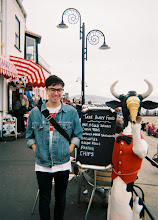

I began to experiment with the idea of the make-up as mask, I have several ways I wish to explore this which I haven't gotten around to as yet, however, I did start to think about the works of two particular artists recently, Levi Van Veluw and Friedrich Hundertwasser. The photographs below are my first attempt at exploring the use of make-up as mask, drawing lines in eye-liner across my face and photographing them using the previously mentioned Polaroid 403R. The first image is the stages of this and the second is used more as documentation. The photographs become documents of an event, like the images left after 60s performance art. That the camera is used to create photographs for documentation is also an applicable and interesting facet. 

Levi Van Veluw's work involves covering his own face and head in various materials, including leather, felt and human hair. His work contains a dual attraction, curiosity and repulsion create feelings of ambivalence in the viewer. These works also follow the vein of performance art in that the photographs are all that is left as documentation of the works. I intend to further expand on his work in a later post.

Friedrich Hundertwasser was part inspiration for my face-contours photographs mostly because of their aesthetic similarities. When first starting these photographs he was not a direct influence, the lines were more a way of exploring the contours of the face through a simple pattern, however, after having studied the photographs more closely, the works of Hundertwasser and the likeness to the painting below became very apparent.

 The camera comes with a built in angled flash and two fixed focussing distances, 1.2m and 1.92m, this means that every image taken with the camera will look fairly consistent with the preceding and following images, particularly when photographing the face. Though there are more complex lighting set-ups for the passport photograph, as in the diagram below, I have found that taking the images with the flash pointing directly at the subject on a white background is similar enough to the passport style for my purposes.
The camera comes with a built in angled flash and two fixed focussing distances, 1.2m and 1.92m, this means that every image taken with the camera will look fairly consistent with the preceding and following images, particularly when photographing the face. Though there are more complex lighting set-ups for the passport photograph, as in the diagram below, I have found that taking the images with the flash pointing directly at the subject on a white background is similar enough to the passport style for my purposes.

